Race Riding KTM’s 125 XC 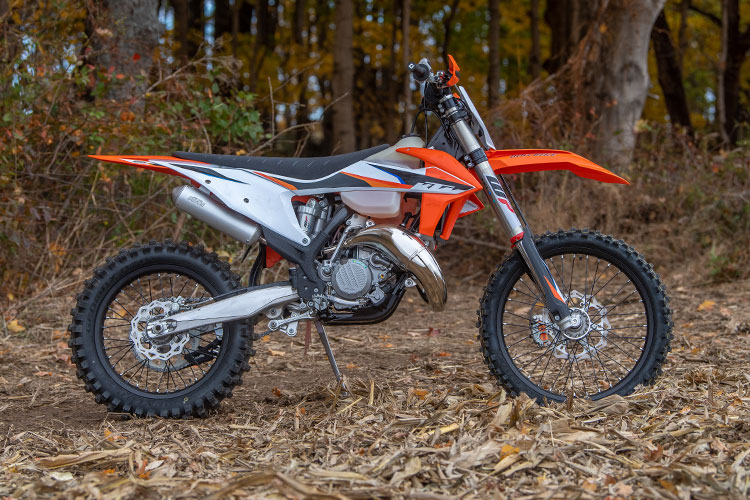
By Brett Smith / Photos Shan Morre
I recently made the mistake of telling DBT’s Jimmy Lewis I wanted to ride a 125 again. Be careful what you tell Jimmy. It might not seem like he pays attention to what you say but he does. I’ve already forgotten the deeper context of how that conversation originated but here I am typing a first ride impression of the 2021 KTM 125 XC. My right thumb is so fat it looks like it was packed in sausage casing. We’re all about to see how good the DBT proofreader is because I’m struggling to tap the spacebar right now. 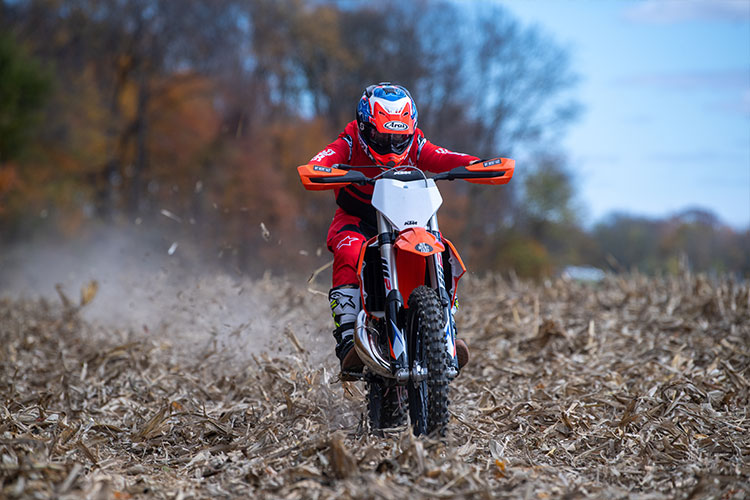
Testing a new 125 model, seems harmless, right? I last rode a 125 in September 2004 when Yamaha released their completely overhauled YZ motocrosser for the 2005 model year. I did a few laps at Glen Helen Raceway the day before the Pro Motocross National. But this test wouldn’t be a few laps followed by a photo session where we hit the same corner over and over to capture the perfect style and angle. Jimmy wanted me to race. Hell, “Ready to Race” is KTM’s motto. It’s printed right on the bike’s graphics. “How would you like to race the Ironman GNCC on a 125?” Jimmy asked me. I looked at my phone screen to double check the caller ID. Then I asked Jimmy how his pool of reporter options got so shallow that he called me. My ability to discuss intricate handling and suspension details is limited and my specialty isn’t explaining how an engine feels at specific RPM ranges. My jam is writing about people and emotions and experiences. I write about humans, not machines. But there I was, assigned. And let’s add in the fact that I haven’t ridden a dirt bike for any meaningful amount of time since flip phones were the hottest piece of pocket technology and two strokes still won the majority of dirt bike championships.
I looked at my phone screen to double check the caller ID. Then I asked Jimmy how his pool of reporter options got so shallow that he called me. My ability to discuss intricate handling and suspension details is limited and my specialty isn’t explaining how an engine feels at specific RPM ranges. My jam is writing about people and emotions and experiences. I write about humans, not machines. But there I was, assigned. And let’s add in the fact that I haven’t ridden a dirt bike for any meaningful amount of time since flip phones were the hottest piece of pocket technology and two strokes still won the majority of dirt bike championships. 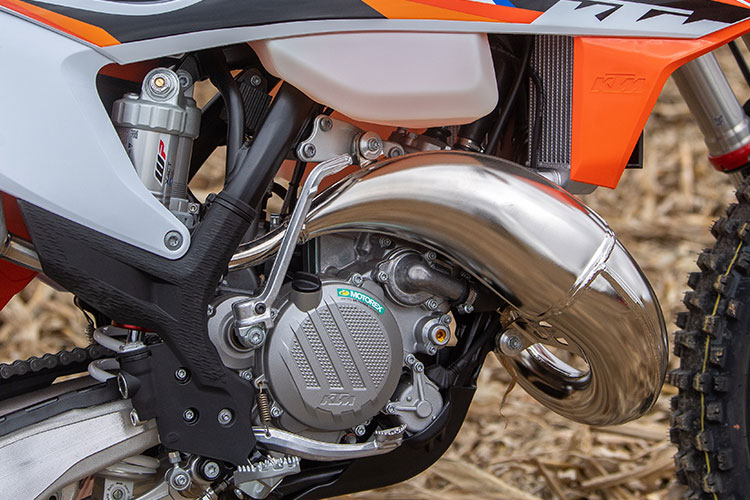
I hesitated, turned it down at first, but then retracted when my wife (my wife!) said it sounded awesome.
The Scene
The Ironman GNCC is an ambitious setting for returning to off-road. But for testing a bike’s capabilities, it’s perfect. For 26 years the Ironman course has tortured motorcycles and riders with 13 miles of roots, river rocks, mud, deep ruts, short (but steep and punchy) climbs and acres upon acres of recently harvested cornfields. Sounds like hell yet 2,420 ATV and motorcycle racers paid money to compete in 2020.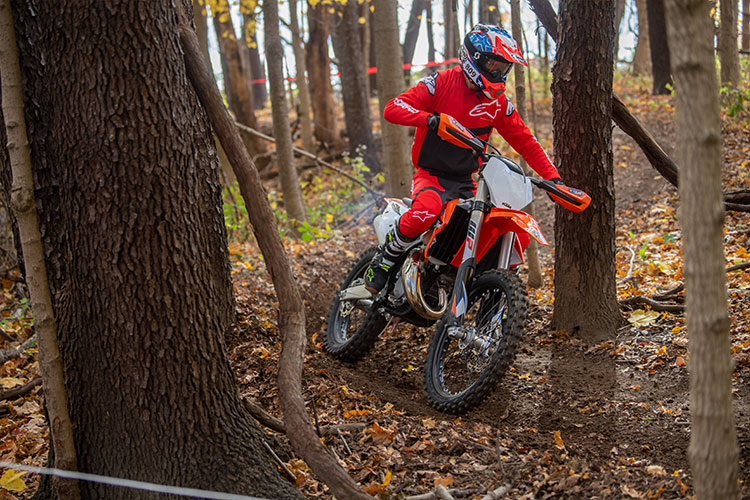
In 2003, I competed in my first (and up to now, only) GNCC. I don’t remember which round but I rode Rodney Smith’s backup Suzuki RM250. It was a disaster. I couldn’t start the bike when the green flag went up and I narrowly escaped getting mowed down by the next wave. While I can’t remember any details about the race, I can still conjure the feelings I had about riding a very potent 250cc two stroke: it was way too much. I’m not Rodney Smith. I didn’t need anywhere near that much power; I’m 140 pounds after a couple of burritos. I didn’t ride that bike as much as it rode me.
Yet, even while scoping out the Ironman course during Saturday’s ATV races, I got the feeling that a 125 might be too little for these steep Indiana climbs and deep mud sections. Less than 18 hours out from the start of my race, however, my rattled nerves could have been convinced of anything.
Why a 125?
In 2017 GNCC implemented a third pro bike class in the afternoon waves. The FMF XC3 125 Pro-Am division bridges the gap between racing a super mini and a 250 four stroke. It proved to be as popular with the youngsters as it was with former XC1 winners. It’s also a highly competitive way to showcase the 125 two strokes available today from Yamaha, KTM, GasGas, Husqvarna, Beta and Sherco. KTM wanted a bike that could line up for this class and other off-road races. The 125 XC is a 125 SX but with the necessary components to hit the trails right off the showroom floor. It has a translucent 2.4-gallon fuel tank vs. the 1.98-gallon tank of the SX, an 18-in. rear wheel, foot pegs set 6mm higher, different suspension valving, hand guards and… ELECTRIC START! (More on that below.) At $7599.00 it’s $200 more than the 125 SX model and $900 more than one of its rivals, the Yamaha YZ 125X, which lacks a few key features like the bigger fuel tank and electric start.
Race Day
My right arm ached while I geared up on Sunday morning. I could feel the forearm tightening. That was bad. I’m not too proud to admit I was nervous. But at least a smile spread across my face the moment I felt the 125 humming underneath me. It all seemed so familiar. The sound, the smell, the vibration, the out-of-place-looking grey button near the throttle. Wait. What? 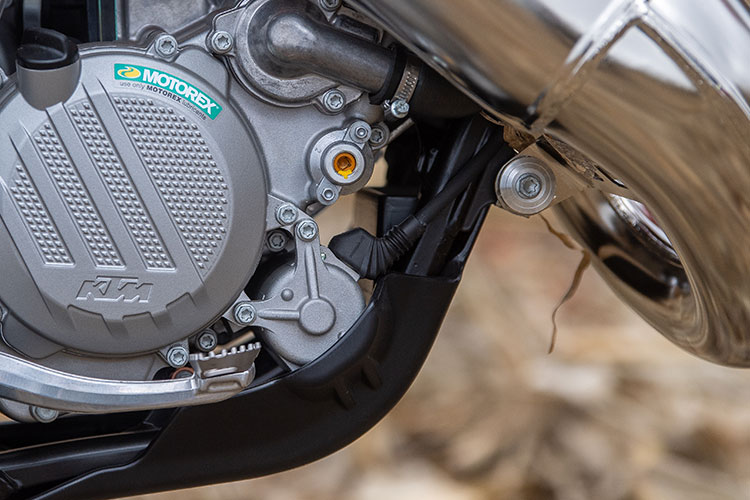
Electric start? On a two stroke! It seemed silly at first. Standing there in my street clothes, I wondered, How hard is it to kick start a 125? But when I finally had the chance to use it, I told myself That’s not the point. Life is full of micro-conveniences now. Take keyless entry in automobiles. We used to stick our keys into doors and turn them to unlock. I’m not this fancy but many cars today even have remote start. It’s not hard to unlock a door or turn an ignition but eliminating these small actions from our lives makes the day just a fraction of a bit easier and faster.
That’s what having electric start on a dirt bike is, only when you’re completely exhausted, not having to exert more energy (or find your balance in a precarious situation) is an incredible feature. And if you really, really want to feel the nostalgia of kicking a metal, L-shaped lever, the KTM 125 XC still comes with a kickstarter. Kickstarters are all I knew before this experience but I only used it on the KTM once and that was just for old time’s sake.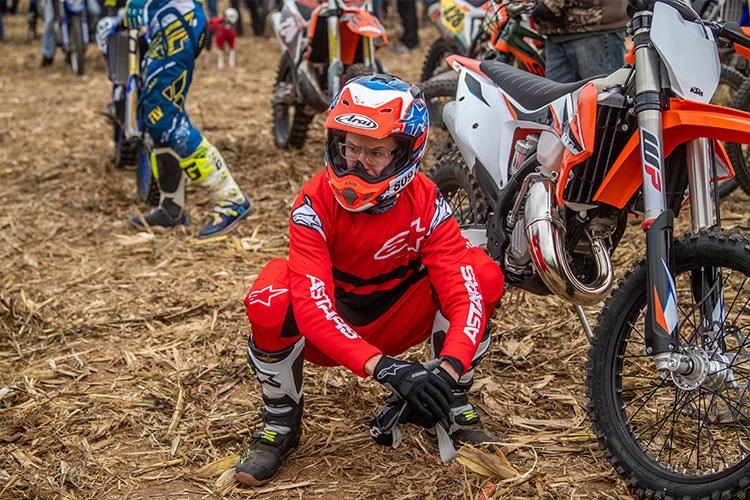
I made up my mind early that I was riding the Ironman GNCC, not racing it. Off the start I hung back on purpose and took my time familiarizing myself with the bike. The only adjustment we made before the race was sag. I’m not picky and I didn’t even touch the levers or bars. Everything felt fine to me. The Ironman course winds through a cornfield before it dips into the woods. I’m an avid mountain biker and I enjoy popping wheelies so the first thing I did when I hit a long straight was stand the KTM up on its rear wheel and rip across the harvested stalks. At that moment I knew I had plenty of power to get me through the next two hours.
Before going to the line, I asked advice from everyone I encountered: GNCC winners Mark Hyde and Fred Andrews, KTM North America President John Hinz, KTM’s Team Manager Antti Kallonen, but it was KTM Factory Racing rider Ben Kelley who had the best tips. He said “Go fast and stand up through the bumps.” 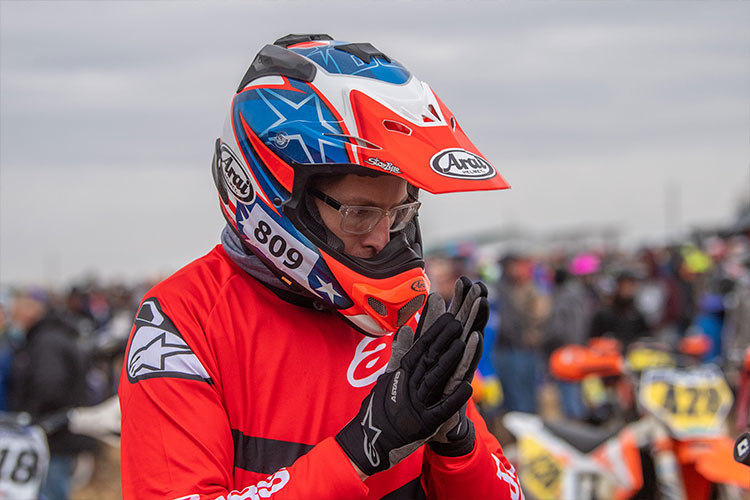
When I dropped into the woods, I kept that second piece in mind. I stood everywhere, through the ruts, over the bumps, roots, rock gardens, log climbs, even in the tight S-turns. The bike felt light underneath me and on the several occasions where I mistimed an obstacle and had to dab a foot, I was able to muscle it back and stay under control. I puckered up at the first steep climb because I wasn’t sure what would happen but I found myself at the top with little effort or fanfare. And this happened over and over on the first lap. This 125 didn’t have the same narrow powerband I remember from my teenage years in the 1990s. The clutch didn’t need the constant attention that I recall but, as Gary Bailey taught us in his training videos, my finger stayed glued to the lever, ready to go. And every time I smelled the familiar odor of fried clutch, it wasn’t me but another rider. The KTM doesn’t need to be ‘on the pipe’ to get results. I chugged along in 2nd or 3rd gear and it didn’t matter if I lugged it, nothing tripped it up. It gave me everything I needed every single time. And if I wanted RPMs in a hurry, the hydraulic clutch made downshifting ridiculously easy. 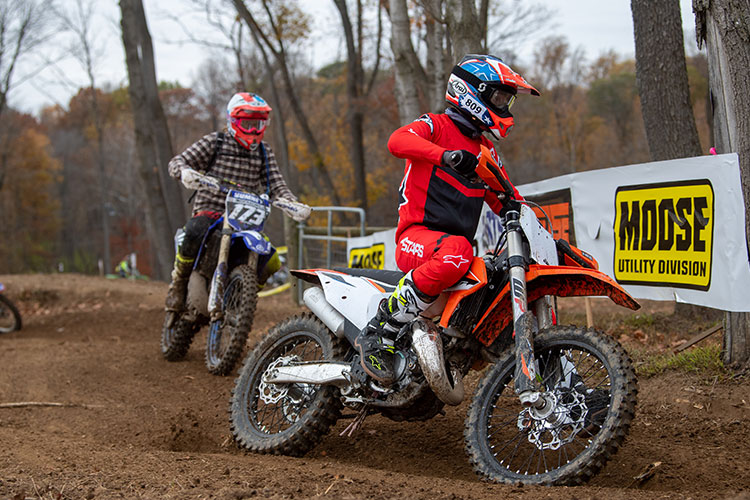
Nine hundred forty seven riders competed in the morning wave at the Ironman, a GNCC record. Every single lap in our two hour race seemed like a different course because the bumps grew bigger and the ruts got deeper. Not that I have a lot to compare it to, but the suspension did its job. We were blessed with cool weather and tacky hero dirt but it was impossible to find a smooth line by the third lap. Pre-race, I expected to have forearms bursting out of my jersey. Those never came and I can’t explain it. That was the roughest course I’ve been on since I was teenager racing motocross in the deep sand tracks of mid-Michigan.
Was it the flexibility of the steel frame? The WP XACT forks and shock with off-road-specific damping systems that I couldn’t possibly understand well enough to regurgitate detailed analysis back to you? Hard to say but this doesn’t mean I wasn’t sore. Two days after the race I could still barely walk down the stairs in my house and I had general stiffness all over. During the race, I didn’t fatigue to the point of miserable and even the throbbing thumb I suffered when a slick root took me down couldn’t wipe the smile off my face at the checkered flag. 
Who is it for?
On the second lap I had a little more confidence to pick up my pace and I found myself passing more riders than I was letting by. In the tight forest sections, I came up quickly on big displacement four strokes and when they heard the unmistakable pitch of a 125 behind them I swear they puffed up their chests and said ‘no way, kid!’ This was especially apparent when we emerged from the woods and I had to drag race across the corn and brake late to make a move. Off-road riders, and especially those loyal to KTM have more bike model choices than other dirt bike disciplines but I wonder how many would get more enjoyment out of riding on a lighter (the 125 XC is 25 pounds less than the 250 XC-F), easier to handle and less expensive two stroke. 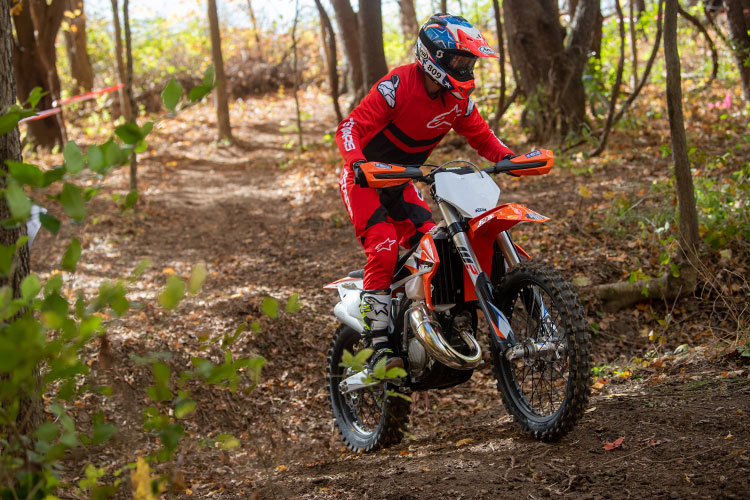
Even KTM’s sales description makes it seem like this 125 is only for a specific demographic: “it delivers superior agility and power to fulfill the demands of any young and aspiring Off-Road racer. This 2-stroke screamer is the ultimate entry point into the pro Off-Road ranks.” I challenge four words in those two sentences: young, aspiring and entry point. You don’t need to be any of these to enjoy a 125 today or get results. And in the end, you’ll likely keep a hell of a lot of money in your pocket for doing so. Editors from two other publications also raced the 125 XC at the Ironman and they each had 40 and 50 pounds on me but had just as much fun. Bike choice is highly personal but in 2021 don’t roll your eyes at off-road 125s because you think they’re gutless, small or difficult to ride. Most of us are not trying to win championships. We just want to have an experience and enjoy the trails. The 125 can help us do both.
Brett Smith is the man behind We Went Fast (wewentfast.com) and is begging for another assignment riding or racing a 125cc dirt bike.
Support DBT by shopping through the links below:

